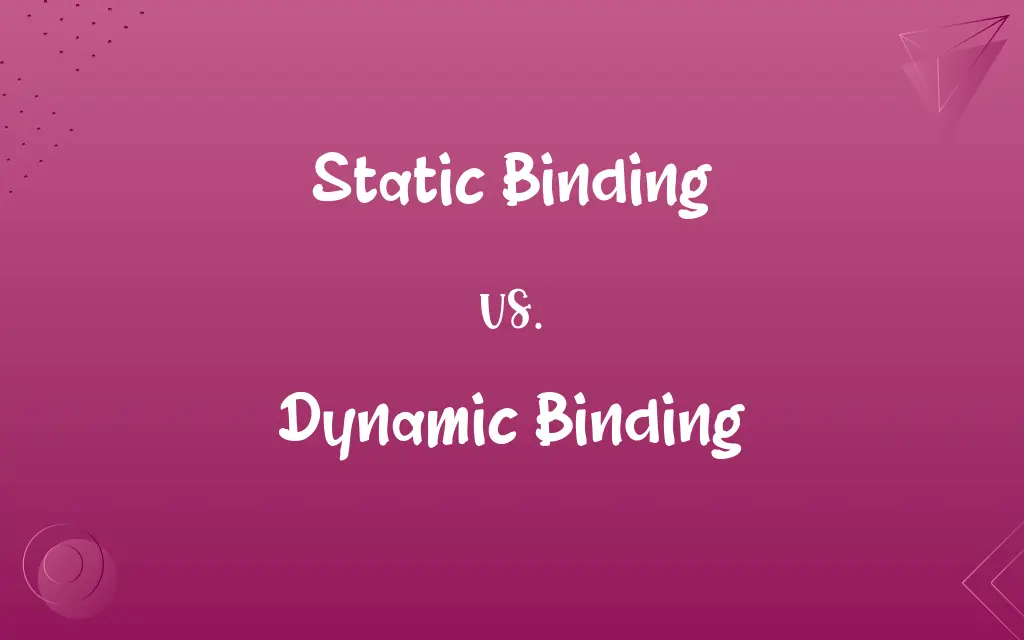Static Binding vs. Dynamic Binding: Know the Difference

By Shumaila Saeed || Published on February 3, 2024
Static binding binds code to its functionality at compile time, whereas dynamic binding does so at runtime.

Key Differences
Static binding, also known as early binding, occurs at compile time. The compiler identifies the method or variable at this stage. Dynamic binding, or late binding, on the other hand, is resolved during runtime. This means that the compiler doesn't determine the method to be called or the variable being referenced until the program is running.
Shumaila Saeed
Feb 03, 2024
In static binding, the type of object is known at compile time, making it faster and more efficient. Dynamic binding, however, allows for more flexibility as the type of object can change at runtime. This is particularly useful in polymorphism where the exact type of object might not be known until the program is in execution.
Shumaila Saeed
Feb 03, 2024
Static binding is generally used for methods and variables that are not expected to change at runtime. This provides a certain level of predictability and stability in code behavior. In contrast, dynamic binding is essential for cases where behavior can vary during execution, such as in instances of method overriding in object-oriented programming.
Shumaila Saeed
Feb 03, 2024
Errors in static binding are caught early during the compilation process, making them easier to debug. Dynamic binding, being resolved at runtime, can lead to runtime errors which are typically harder to trace and resolve. This highlights a trade-off between predictability and flexibility in the two binding types.
Shumaila Saeed
Feb 03, 2024
Static binding is often associated with languages that emphasize compile-time checks, like C++. Dynamic binding is a characteristic of languages that prioritize runtime flexibility, such as Python. Both forms of binding play crucial roles depending on the programming paradigm and requirements of the software being developed.
Shumaila Saeed
Feb 03, 2024
ADVERTISEMENT
Comparison Chart
Flexibility
Less flexible, as types and methods are fixed
More flexible, can handle varying types at runtime
Shumaila Saeed
Feb 03, 2024
Performance
Generally faster due to early resolution
Slightly slower due to runtime resolution
Shumaila Saeed
Feb 03, 2024
Error Detection
Errors are detected at compile time
Errors are detected at runtime
Shumaila Saeed
Feb 03, 2024
Use in Programming Paradigm
Common in statically typed languages
Common in dynamically typed languages
Shumaila Saeed
Feb 03, 2024
ADVERTISEMENT
Static Binding and Dynamic Binding Definitions
Static Binding
Static binding links a function call to a specific method at compile time.
Int result = Math.add(5, 3); // The method add() is statically bound.
Shumaila Saeed
Jan 24, 2024
Dynamic Binding
Dynamic binding determines which method or variable to call or use at runtime.
Animal.makeSound(); // The specific makeSound() method is determined at runtime.
Shumaila Saeed
Jan 24, 2024
Static Binding
It is a form of binding in which the method to be executed is known early during compilation.
Car.start(); // start() method is resolved at compile time through static binding.
Shumaila Saeed
Jan 24, 2024
Dynamic Binding
It refers to the late binding of functions and variables, occurring at runtime.
Button.onClick(); // onClick() behavior is determined when the button is actually clicked.
Shumaila Saeed
Jan 24, 2024
Static Binding
Static binding happens when the type of the object is known and fixed during the code compilation.
Double area = Circle.calculateArea(radius); // calculateArea() is a static binding example.
Shumaila Saeed
Jan 24, 2024
ADVERTISEMENT
Dynamic Binding
It's a binding process where method calls are resolved during program execution.
For (Shape shape : shapes) { shape.draw(); } // draw() method is dynamically bound.
Shumaila Saeed
Jan 24, 2024
Static Binding
It's the association of a function call to the specific code to be executed, determined at compile time.
System.out.println(Hello, world!); // println() is statically bound.
Shumaila Saeed
Jan 24, 2024
Dynamic Binding
Dynamic binding allows method calls to be resolved based on the object's runtime type.
Employee.calculateSalary(); // The type of employee determines which calculateSalary() is called.
Shumaila Saeed
Jan 24, 2024
Static Binding
Static binding is the process of resolving references to functions or variables at compile time.
String name = person.getName(); // getName() is statically bound.
Shumaila Saeed
Jan 24, 2024
Dynamic Binding
Dynamic binding enables polymorphic behavior in object-oriented programming.
Transport.move(); // move() method depends on the runtime type of transport.
Shumaila Saeed
Jan 24, 2024
Repeatedly Asked Queries
When is Dynamic Binding preferred?
It's preferred when method calls depend on the runtime type of the object, allowing for flexible execution.
Shumaila Saeed
Feb 03, 2024
What is Static Binding?
Static binding is the process of linking a method call to its definition at compile time.
Shumaila Saeed
Feb 03, 2024
What is Dynamic Binding?
Dynamic binding links a method call to its definition at runtime, allowing for polymorphism.
Shumaila Saeed
Feb 03, 2024
Can Static Binding lead to faster execution?
Yes, because method calls are resolved at compile time, reducing runtime overhead.
Shumaila Saeed
Feb 03, 2024
Does Dynamic Binding support polymorphism?
Yes, it is fundamental to polymorphism, allowing objects of different classes to be treated uniformly.
Shumaila Saeed
Feb 03, 2024
Can Dynamic Binding lead to runtime errors?
Yes, since method resolution happens at runtime, errors may not surface until execution.
Shumaila Saeed
Feb 03, 2024
How does Dynamic Binding enhance polymorphism?
It allows different classes to define their own implementations of a method, enhancing polymorphism.
Shumaila Saeed
Feb 03, 2024
Is Static Binding associated with specific programming languages?
It is more common in statically-typed languages like Java and C++.
Shumaila Saeed
Feb 03, 2024
When is Static Binding used?
It's used when the method to be executed is known at compile time and doesn't change at runtime.
Shumaila Saeed
Feb 03, 2024
How does Static Binding affect polymorphism?
It limits polymorphism as the method called is determined at compile time and doesn't vary.
Shumaila Saeed
Feb 03, 2024
Does Dynamic Binding require more memory?
It might require more memory and processing power due to its runtime nature.
Shumaila Saeed
Feb 03, 2024
Are Static Binding errors easier to debug?
Yes, as they are detected at compile time, making them easier to identify and fix.
Shumaila Saeed
Feb 03, 2024
Is Static Binding more predictable than Dynamic Binding?
Yes, because the binding is determined at compile time, making the behavior more predictable.
Shumaila Saeed
Feb 03, 2024
Is Dynamic Binding typical in certain programming languages?
Yes, it is typical in dynamically-typed languages like Python and JavaScript.
Shumaila Saeed
Feb 03, 2024
Can Static Binding be overridden?
No, once a method is statically bound, it cannot be overridden at runtime.
Shumaila Saeed
Feb 03, 2024
Do all programming languages support both bindings?
Most modern languages support both, but their implementation and emphasis can vary.
Shumaila Saeed
Feb 03, 2024
Is Dynamic Binding slower than Static Binding?
It can be slower due to the runtime resolution of method calls.
Shumaila Saeed
Feb 03, 2024
Can Static Binding be used for final methods?
Yes, final methods are ideal candidates for static binding as they cannot be overridden.
Shumaila Saeed
Feb 03, 2024
Is one binding method better than the other?
Each has its advantages and is better suited for different scenarios; neither is universally superior.
Shumaila Saeed
Feb 03, 2024
Can Dynamic Binding change the behavior during execution?
Yes, it can change behavior based on the actual object's type at runtime.
Shumaila Saeed
Feb 03, 2024
Share this page
Link for your blog / website
HTML
Link to share via messenger
About Author
Written by
Shumaila SaeedShumaila Saeed, an expert content creator with 6 years of experience, specializes in distilling complex topics into easily digestible comparisons, shining a light on the nuances that both inform and educate readers with clarity and accuracy.








































































